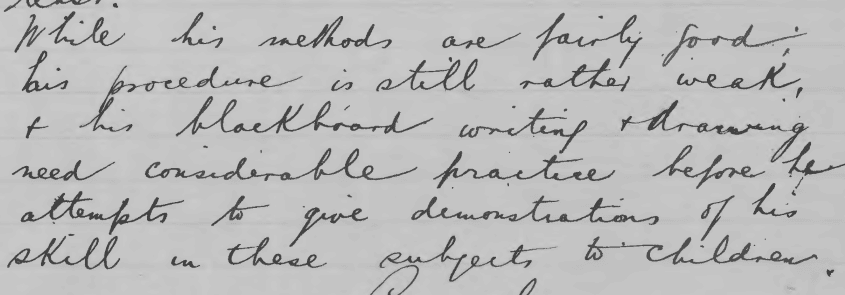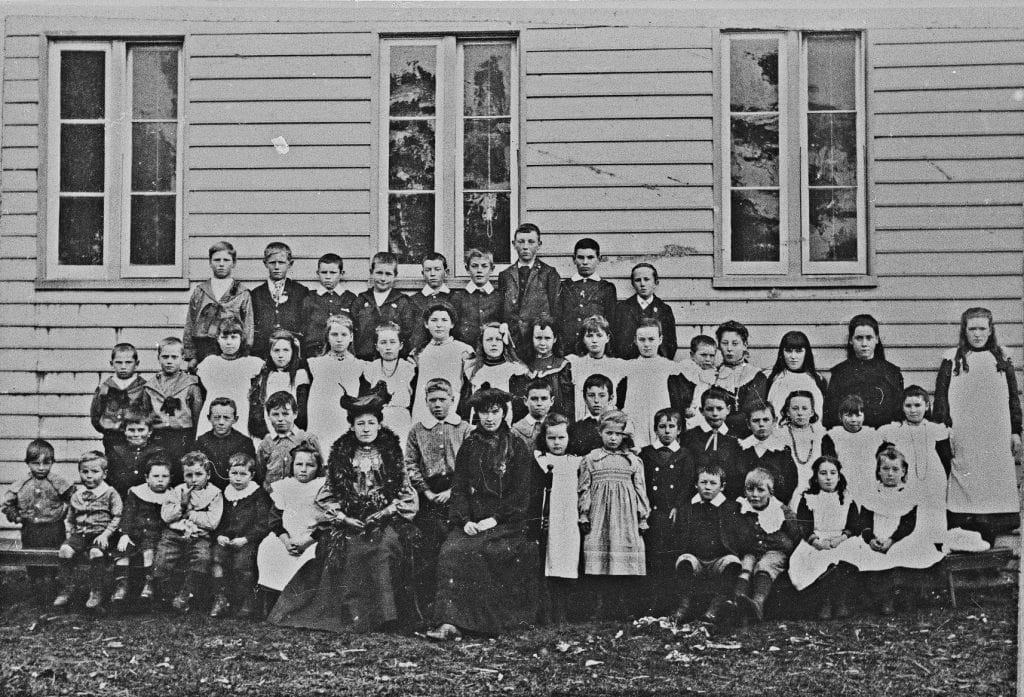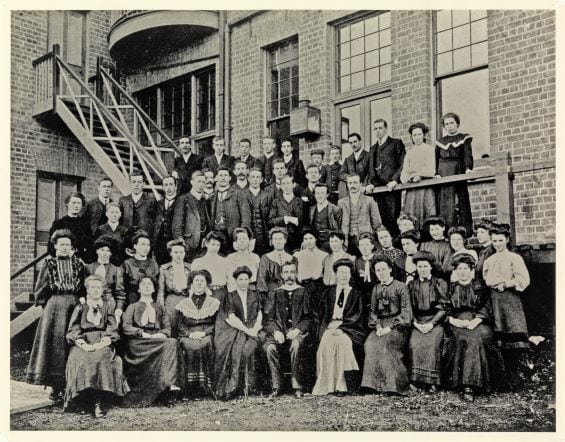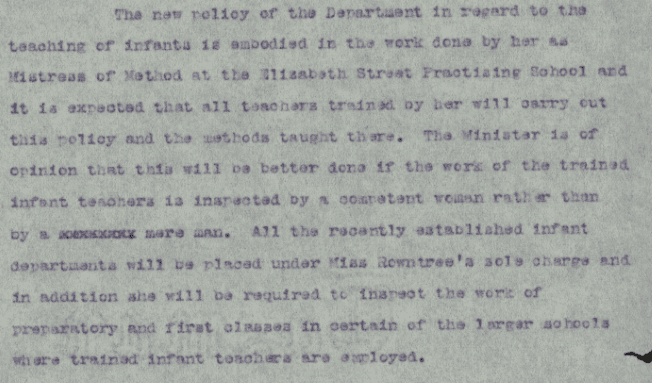Teaching in Tasmania: three teachers’ lives, 1868-1945

We can only imagine what it must have been like to be the first teacher in Tasmania. Jane Noel was a Sydney schoolmistress who began a private school in a hut in a lane off the lower end of Collins Street in Hobart Town in 1806. What follows is a brief look at the lives of three of Jane’s successors between 1868 and 1945. It is also a research journey, investigating the sometimes dark nooks and crannies of the collections of the Tasmanian State Library and Archives. What you think you will find on these journeys is sometimes very different than what you begin looking for, but it is always illuminating.

When I started this research, my plan was to do several case studies of teachers using our records, and link their stories to the qualifications they had, how they got them and what they meant at the time. What I ended up with instead was a look into their lives, a window onto the lived experience of teaching in Tasmania over 150 years. Inside the records of the Education Department I found astonishing personal stories. The respectful but strident statements of a young woman refusing to transfer to a school because she knew what it was like there for her predecessor. The struggles of a young man whose teaching career was interrupted by his service in World War I and the difficulties and challenges on his return. The sense of loss and indignation of a high achieving woman in the 1940s, calmly and professionally writing to the Minister of Education asking for pay parity.
Read on to discover these stories and more, as well as resources for research on the dates, details and evolutions of teachers and their training in Tasmania.
Maximilian Nicholls: From Tasmania to the Trenches and back again
Max Nicholls first appears in our records on the 30th of January 1890 on the Register for Admissions to the Hutchins School in Hobart.

Born on 30 June, 1879 in Ballarat, Max was the brother of Sir Herbert Nicholls, judge, politician and lieutenant-governor of Tasmania from 23 December 1930 to 4 August 1933. Max applied to be a member of staff at the East Launceston Practising School on the 3rd of May 1909.

Max began teaching at East Launceston under the supervision of Acting Head Teacher George Hunt who, although glowing in his praise of Max’s abilities, still believed by July that:

By September, Mr Hunt finalised his report on Max, and although Mr Hunt found Max had a few things to work on:

He was generally happy with his progress and believed that with practice he would be a good teacher:

Max’s next school was at Saltwater River, and this photo may show some of his pupils, posing with their parents and a bounty of cheeses sometime around 1910.

But Max’s file is silent on his own experiences at the Tasman Peninsula school. After he left, one of the mothers (perhaps pictured above?) wrote to the Director of Education to complain about the “irregular” education her children were receiving. She wrote, “Under the last teacher viz Mr Nichols they had got a good start, now with no teacher to go back again,” and added that if no teacher was appointed that she would be “compelled in justice to my children to send them away to where they can get some schooling.”

As for Max’s fortunes in the Education Department, our records are silent. The story of his career between 1912 and 1915 might be buried deep in a correspondence file or a school’s record books that have not been indexed.
What we do know is that on the 28th of July, 1914, World War I erupted, and we next find Max in New South Wales enlisting to fight one year later, in August 1915. There is a detailed account of Max’s wartime service available on the Australian War Memorial site here. He was a private with 30 Battalion AIF whose first major battle was at Fromelles in July 1916. On the 2 April 1917, he was evacuated to the 3rd General Hospital with shell shock, what we now call Post Traumatic Stress Disorder or PTSD. This condition would recur several times until it saw him removed from active operations on the 25th of February 1918 “for reclassification on medical grounds.’
In the collections of the Australian War Memorial, is a violin made by Max while he was serving in France.

He wrote in 1948:
Work was chiefly with a pocket knife. As I was with an intelligence corps I was able to keep the violin in a secure place when on duty. The body of the violin is made from a small field telephone box and the neck was cut from a German rifle. The bow was made from a stick which had a German notice printed on a disc, stating ‘Hoch spannung! Gefahr zu Leben!’ (High tension wires! Danger to life!).
Australian War Memorial
A slightly disturbing part of the violin is the tail piece. This was made from a patella, a human knee cap that Max had found in Delville Wood. One can only wonder what his colleagues must have thought when Max started making musical instruments out of human body parts. He did return to teaching in Tasmania briefly but by the 1920s was living on the sparsely populated Lord Howe Island. Perhaps he never fully recovered from his ordeal in the war and the quieter life on Lord Howe appealed to him, he was appointed a teacher there on the 4th of January 1924.
He wrote “A History of Lord Howe Island” first as a pamphlet in 1938 and then as an expanded book edition in 1951, both of which are available in our library collection.
Flora Wesley: “By the time several of the leading residents have picked at the teacher, there is very little left of her except her bare bones.”

Flora Wesley, pictured here in 1910 with students from Southport State School was born on the 19th of September, 1868 in Suffolk, England. Flora is the teacher sitting in the front row on the left, and she had been living in the colony for nine years when she first applied for a teaching position on the 18th of September 1894. The 26 year old explained on her teaching application that she had no experience in teaching, and her previous employment had been seven years in the employ of the late Mr [Henry?] as Milliner, that is a hat maker. Perhaps some of what she learnt in her previous employment can be seen in her impressive hat and feather boa worn in the school photo above.

Her application was accompanied by many glowing character references such as this one from Hamilton’s Superintendent of Police, John Farrell. What is fascinating with these character references is their emphasis on Miss Wesley’s character, very little is said about her teaching ability. It reinforces what my colleague Anna found in her previous blog entry, that school was primarily a place to reform and contain children and to teach them some manners.

Miss Wesley’s application was accepted, and she subsequently passed her entrance exam held in January 1895. But neither her exam nor her references guaranteed a job, and she soon wrote to The Director of Education, Mr J Rule, stating that:
“I have been out of employment for some time and my circumstances is very straightened. I should be very grateful if you could find me a place under the large staff employed under you”
ED2/1/1466: Flora Wesley to Director of Education J. Rule, 10 February, 1895
On the cover of her ED2/1/1466 file, (her application for a teaching position, which is available online), it mentions that she had to wait nearly a year before she received an appointment to Barton School in Campbell Town:

She was at Lady Bay School in January 1901, and in a letter requesting a transfer said that she had been there for three years, she tried to move to a new position in a town school, writing to the Minister of Education that after three years, she “would appreciate a change.”

Two years later, she was still at Lady Bay, and although she was still keen for a transfer, there were some schools that she was hesitant to go to, especially Ouse School. She wrote to the Director of Education how well she remembered that,“By the time several of the leading residents have picked at the teacher, there is very little left of her except her bare bones.”

The last letter in her file is from March 1904 to School Inspector Lovell confirming that she has been appointed teacher in charge of Hythe, later Southport. She was still there in 1910 when the photograph at the start of this section was taken.

Miss Wesley died 11th July 1944 at her home in Macquarie Street.
Amy Rowntree: “A Sweetening and Strengthening Influence”


Miss Amy Rowntree was born in Hobart on the 13th of July 1885. She became a pupil teacher in January 1902, and after an appointment to Geeveston State School, joined the first intake at Philip Smith Training College in Hobart when it opened in 1906. After teaching for four years, Miss Rowntree spent 1912-1913 studying kindergarten methods at the Teachers College in Sydney under Martha Simpson. This is where she would find her passion, and make her mark on the history of teaching in Tasmania and beyond. She details her experiences in Sydney in a delightful series of letters which she wrote to Mr William Taylor McCoy, Director of Education. They are contained in our general correspondence file for the Education Department, ED9/1/1146, and some excerpts from them follow.
Sydney was both a joy and a shock for a young woman from Tasmania, on the 14th of March, 1912 she wrote to Director McCoy:
It is certainly an education to live in Sydney. I walked from the Girls High School to the Railway last night, and it was a twenty minutes I shall never forget. One sees enough wickedness and vulgarity during the day, but the night inhabitants of George Street look to be half criminals.”
As for the work itself, her enthusiasm, passion and sheer joy literally leap off the page.
Of her instructor, she wrote on the 11th of May, 1912:
“If I hadn’t a home in Hobart, that is to say if I hadn’t left my heart there, I’m sure you’d never see me again. I just love Blackfriars, and am very happy there. I cannot tell you how much I admire Miss Simpson, I think she is simply grand. Just at the present she has much to worry her, but she is always just as kind, just as smiling with the children, just as well-balanced and dignified.”
Although seeming nervous at first, the passion which Miss Rowntree would bring to educational change in early childhood can be seen in this comment from the same letter:
“It is so easy to be a Kindergartener in Sydney with many others around one, and with Miss Simpson believing in you, but it will take more care to stand really alone next year. (But there’s the IF in it after all.) I could be a really fine Kindergartner if I were always under Miss S. because she seems to radiate the power somehow, and she believes in one so confidently. I don’t want to be a second-rate arrangement. I want to be the very best, I want Tasmanian Kindergarteners to be able to compare with any.”
Amy was appointed Mistress of Method at the Elizabeth Street Practising School in 1914. In the 1920s photo below of the Elizabeth Street Practising School, Amy is seated in the front row centre.

On the 7th July 1919 she was promoted to Inspector of Infant Schools, the first woman to achieve such an appointment in Tasmania. In a letter to the Minister of Education requesting her appointment to the traditionally male job, Director McCoy had this to say:

He also wrote a media release to the editor of The Mercury (which was published under the title of “Items of Interest: A Woman School Inspector”). In it, McCoy made clear on where the opinions of the Minister of Education stood regarding gender and infant teachers, namely that the newly trained infant teachers should be inspected “by a competent woman rather than by a mere man.”

Times were tough worldwide during the Great Depression, and Tasmania was no exception. On the 23rd of July 1931 Amy wrote to the Director of Education following a recent conversation:

She laid out the reasons why her position should be maintained. This letter can be read in full in the History Room. For me, the most forward thinking and moving passage is:

The Director was impressed by her cogent and persuasive arguments and replied:

Another area where Amy was ahead of her time was in the inequality of the gender pay gap. On the 28th of March 1940 she wrote to the Director of Education regarding the large disparity between her pay and that of her male counterparts.
What seems to have precipitated the letter was a rise for the house allowance paid to Education Officers, perhaps one last indignation on top of years of unequal pay. In her letter, she pointed out that when she was appointed as the first female Inspector of Schools in Tasmania in 1919, it was made clear to her that she would be paid at the same scale as other “women officers” on the mainland – 80% of the pay of a man in the same position. But the pay of male officers had been steadily increased, and hers had remained the same for more than 20 years, and she hadn’t received any additional incentives like housing allowances.
![Part of a handwritten letter. The text reads:” When I was appointed on inspector in Tasmania, over twenty years ago, Mr McCoy made this the general basis of my salary. Since then, the salaries of our men inspectors were raised to place them ahead of any well-paid teachers [I was not included in that rise] When I returned from England last year, I was told that all E.O’s were to receive a further rise of 30 pounds for house allowance. I was pleased to find that my services were to receive equal recognition with those of my colleagues. To-day Sir you suggest that, for reasons which I cannot follow, I am not eligible for the house allowance. Under the circumstances I am asking for a revision of the salary to be paid to the woman education officer of this department. At present the men of my standing are receiving 430 Pounds p. a”](https://cdn.shortpixel.ai/spai/q_glossy+to_auto+ret_img/libraries.tas.gov.au/wp-content/uploads/Amy-Rowntree-6b-resized.png)
Being a professional working women in the 1940s was not easy, as Amy went on to illustrate. She pointed out that she had chosen to remain single for the sake of her profession (a painful position for one who loved children). In her view, that meant she was obligated to learn as much as she could on behalf of both Tasmanian teachers and children, while supporting other relatives financially.

The Director’s reply is not in Amy’s file, and one wonders what justification he made? Nine years later, Amy was awarded the Order of the British Empire (OBE) for her services to education.
Amy continued to work for the Education Department until her retirement on the 13th of June, 1951. Even then, she continued to act for a short period as a Teacher Recruiting Officer for the Education Department.
She was also a prolific researcher and writer of history, the majority of which is available to view in the collections of Libraries Tasmania.
Veda Veale in her 1981 book, Women to Remember summed up Amy’s professional life succinctly and powerfully when she said:
“She was a woman far ahead of her time and in her working years changed the role of women in education from passive acceptance to active policy-making not only within the framework of child education but also in effecting the admission of women as worthwhile contributors in every aspect of the educative process.”
Conclusion
There have been many changes in the teaching profession since Jane Noel first conducted classes in a dusty lane off Collins Street in 1806. Some of the challenges faced by teachers in the past still exist today. Good relationships between teachers and the school communities they serve is still vitally important. Any modern teacher can understand Flora Wesley’s fears about being asked to transfer to a school where this was known to be a problem. So too is the supportive partnership between a student teacher and their supervisor, as Max Nichols must have keenly felt during his time at the East Launceston Practising School. Some of the issues of the past have slowly changed over time. The gender pay gap that Amy Rowntree faced is still very present in our society. Thankfully though, both male and female staff in Tasmania’s contemporary education system are paid the same rate, and women no longer have to remain single if they wish to pursue a professional career.
This story is also about the surprising things you can uncover in your own research journey. Unprepossessing government files can contain moving correspondence that sheds light on the everyday struggles of extraordinary people. We’ve digitized many of these, like Applications for Registration of a Teacher (CB23/6); Applications for Teaching Positions and Associated Correspondence (ED2); Even just a little digging in the archives can completely change your perspective and research direction – and if you’d like to give it a try, we are here to help.
Below you’ll find timelines, references and further reading – and you can always contact us in person or via our research service, which you can find here. Happy researching!
Timeline
The following timeline shows selected events pertinent to the teaching profession in Tasmania, and is modified from Eric G. Nichol’s 1967 thesis, “Teacher Training in Tasmania, 1868-1967” and Clifford Reeves 1935 book, A History of Tasmanian Education. Volume 1. State Primary Education. For a more comprehensive timelines I would recommend referring to those two sources.
1806: Jane Noel started teaching in Collins Street; The Orphan School first suggested
1828: First Orphan School established in Hobart
1846: Reversion to denominational scheme – penny a day system; Hutchins School in Hobart founded; Launceston Grammar founded
1848: High School, Hobart Town, founded
1850: Thomas Arnold appointed inspector; Normal School for training of teachers established
1854: Preliminary entrance examination for teachers
1859: First appointment of ‘itinerating’ teachers. Pupil teacher scheme established
1868: Public Schools Act: first compulsory public schooling in Australia
1870: General examination for teachers
1906: Act for Registration of teachers and schools; Training college established; introduction of trained teachers from South Australia
1911: Philip Smith Training College built
1913: Establishment of State High Schools
1918: Technical Education Branch established; Increase in teacher’s salaries
1920: Teacher’s training course extended to eighteen months
1925: Classification certificates for teachers introduced
1933: Course at college reduced from eighteen months to twelve months due to the Depression
1936: University of Tasmania introduced a course for the Diploma in Education
1937: College staff restored to the size it was before the Depression-era cuts; In-service training for current teachers introduced
1946: Professor of Education appointed at UTAS
1948: University takes over teacher training, mainly for secondary school teaching
1952: Launceston Teachers’ College opened
1955: Tasmanian Teacher’s Certificates introduced
1964: Hobart Teacher’s College re-opened
1967: Three year training course implemented by both Launceston and Hobart Colleges
1968: Four year course for secondary school teachers introduced
References & Further Reading
Explore 150 years of public education in Tasmania
Primary Sources
CB23/6: Applications for Registration of a Teacher, 1910-1991 [DIGITIZED to 1935]
ED2: Applications for Teaching Positions and associated Correspondence, 1862-1905 [DIGITIZED]
ED9, General Correspondence (3), Education Department, 1905-1916
ED10: Correspondence (“o” Series). 1917-1941
ED31: Inspectors’ Reports on Staff, Teaching and Organisation of Schools, 1890-1970
Secondary Sources
Betty Jones, School Days, School Days… Land of Youth and Dream. Tasmanian Government Schooling from its Beginnings in the Nineteenth Century – Part I. Rosny Park: Tasmanian Family History Society Inc, 2017.
Derek Philips and Michael Sprod, Making More Adequate Provision: State Education in Tasmania, 1839-1985. Hobart: Education Department of Tasmania, 1985.
Clifford Reeves, A History of Tasmanian Education. Volume 1. State Primary Education. Melbourne: Melbourne University Press, 1935
Michael Sprod, ‘Education’ in Alison Alexander (ed), Companion to Tasmanian History. Centre for Tasmanian Historical Studies (2005), University of Tasmania (2017)
Hello i hope your well.could anyone help me please.im looking for the name of the school that hilda may jones went to in southern tasmania
Hi Beth, if you would like to fill in our research enquiry form to tell us more information about your question (date of birth, parents, when she would have gone to school), we can have someone look into that for you: https://sltas.altarama.com/reft100.aspx?key=Research
John James Low was also my gg grandfather . Inertested in finding out more if you have it .
William Richard Low
Hi Bill, if you would like help with research into your family history and the Tasmanian Archives, please send your question through our form and a researcher will look into it.
1841 six teachers and their families arrived in Hobart aboard the William Wise to start/assist with the education system. Including John James Low, my gg grandfather. He taught at Richmond
In 1847 he started a private school at Richmond, Harrow Hill, and later he was at the orphan school.
His sister, Elizabeth Ann Low also emigrated and was a teacher
His son, John Joseph, was also a teacher at Latrobe, Invermay and New Town